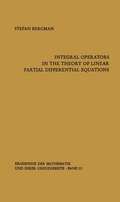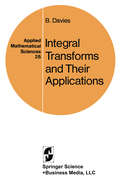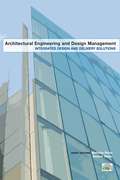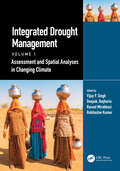- Table View
- List View
Integral Investing: From Profit to Prosperity
by Mariana BozesanToday, early-stage investors and entrepreneurs find themselves in a dilemma in which they must choose between profit and impact; between traditional, for-profit-only models on the one hand, and multiple-bottom-line structures with a positive social or environmental impact on the other. To help them, and in response to a time in which climate change, exponentially growing technologies, and COVID-19 are calling into question humanity’s priorities, the author proposes a new investment paradigm, namely Integral Investing.Integral Investing incorporates and transcends the best practices of both traditional venture capital and impact investing. It provides a seamless integration and shows how technological progress need not be our rival, but can instead be our ally in ensuring the prosperous society we all want. Drawing on her own investments and stellar track record in Silicon Valley and Germany over the past 25 years, the author reveals the mechanism of Integral Investing. At the heart of it is a powerful, 360-degree de-risking tool called the Theta Model, which reveals how to make smart investment decisions based on the comprehensive integration of traditional due-diligence criteria, sustainability metrics, and assessments of the founders’ and team culture. But it doesn’t stop there. In turn, the book demonstrates how to use human-centered AI to scale and digitalize the investment process. The goal here is to accelerate the use of exponential tech, capital, and consciousness leadership to transition to a sustainable global society: a process the author refers to as the Investment Turnaround. The 21 principles of Integral Investing, which she defines using Ken Wilber’s Integral Theory, lead to her manifesto on how to implement the UN Sustainable Development Goals within Planetary Boundaries by 2050 through early-stage investing and entrepreneurship. Similar to the 15th century, when the Medicis inspired the Renaissance, today humanity is once again at a crucial turning point where pioneering financiers, investors, entrepreneurs, and other committed individuals have the opportunity to leave behind the legacy of a prosperous society. This handbook provides a source of inspiration, and shows how self-actualization, a positive mindset, and a consciousness that is backed by a world-centric desire can become the driving force for solving the global grand challenges.
Integral Methods in Science and Engineering: Analytic and Numerical Techniques
by Mario Paul Ahues Alain R. Largillier* Good reference text; clusters well with other Birkhauser integral equations & integral methods books (Estrada and Kanwal, Kythe/Puri, Constanda, et al). * Includes many practical applications/techniques for applied mathematicians, physicists, engineers, grad students. * The contributors to the volume draw from a number of physical domains and propose diverse treatments for various mathematical models through the use of integration as an essential solution tool. * Physically meaningful problems in areas related to finite and boundary element techniques, conservation laws, hybrid approaches, ordinary and partial differential equations, and vortex methods are explored in a rigorous, accessible manner. * The new results provided are a good starting point for future exploitation of the interdisciplinary potential of integration as a unifying methodology for the investigation of mathematical models.
Integral Methods in Science and Engineering, Volume 1: Analytic Methods
by Maria Eugenia PerezThe two volumes contain 65 chapters, which are based on talks presented by reputable researchers in the field at the Tenth International Conference on Integral Methods in Science and Engineering. The chapters address a wide variety of methodologies, from the construction of boundary integral methods to the application of integration-based analytic and computational techniques in almost all aspects of today's technological world. Both volumes are useful references for a broad audience of professionals, including pure and applied mathematicians, physicists, biologists, and mechanical, civil, and electrical engineers, as well as graduate students, who use integration as a fundamental technique in their research.
Integral Methods in Science and Engineering, Volume 2: Computational Methods
by Maria Eugenia PerezThe two volumes contain 65 chapters, which are based on talks presented by reputable researchers in the field at the Tenth International Conference on Integral Methods in Science and Engineering. The chapters address a wide variety of methodologies, from the construction of boundary integral methods to the application of integration-based analytic and computational techniques in almost all aspects of today's technological world. Both volumes are useful references for a broad audience of professionals, including pure and applied mathematicians, physicists, biologists, and mechanical, civil, and electrical engineers, as well as graduate students, who use integration as a fundamental technique in their research.
Integral Operators in the Theory of Linear Partial Differential Equations (Ergebnisse der Mathematik und Ihrer Grenzgebiete. 1. Folge #N. F., 23)
by Stefan BergmanIntegral Sustainable Design: Transformative Perspectives
by Mark DeKayThis book offers practical and theoretical tools for more effective sustainable design solutions and for communicating sustainable design ideas to today's diverse stakeholders. It uses Integral Theory to make sense of the many competing ideas in this area and offers a powerful conceptual framework for sustainable designers through the four main perspectives of: Behaviours, Systems, Experiences and Cultures. It also uses human developmental theory to reframe sustainable design across four levels of complexity present in society: the Traditional, Modern, Postmodern, and Integral waves. Profuse with illustrations and examples, the book offers many conceptual tools including: - Twelve Principles of Integral Sustainable Design - Sixteen Prospects of Sustainable Design - Six Perceptual Shifts for Ecological Design Thinking - Five Levels of Sustainable Design Aesthetics - Ten Injunctions for Designing Connections to Nature
Integral Sustainable Design: Transformative Perspectives
by Mark DeKayThis book offers practical and theoretical tools for more effective sustainable design solutions and for communicating sustainable design ideas to today's diverse stakeholders. It uses Integral Theory to make sense of the many competing ideas in this area and offers a powerful conceptual framework for sustainable designers through the four main perspectives of: Behaviours, Systems, Experiences and Cultures. It also uses human developmental theory to reframe sustainable design across four levels of complexity present in society: the Traditional, Modern, Postmodern, and Integral waves. Profuse with illustrations and examples, the book offers many conceptual tools including: - Twelve Principles of Integral Sustainable Design - Sixteen Prospects of Sustainable Design - Six Perceptual Shifts for Ecological Design Thinking - Five Levels of Sustainable Design Aesthetics - Ten Injunctions for Designing Connections to Nature
Integral Transforms and Their Applications (Applied Mathematical Sciences #25)
by B. DaviesThis book is intended to serve as introductory and reference material for the application of integral transforms to a range of common mathematical problems. It has its im mediate origin in lecture notes prepared for senior level courses at the Australian National University, although I owe a great deal to my colleague Barry Ninham, a matter to which I refer below. In preparing the notes for publication as a book, I have added a considerable amount of material ad- tional to the lecture notes, with the intention of making the book more useful, particularly to the graduate student - volved in the solution of mathematical problems in the physi cal, chemical, engineering and related sciences. Any book is necessarily a statement of the author's viewpoint, and involves a number of compromises. My prime consideration has been to produce a work whose scope is selective rather than encyclopedic; consequently there are many facets of the subject which have been omitted--in not a few cases after a preliminary draft was written--because I v believe that their inclusion would make the book too long.
Integral Transforms and Their Applications (Texts in Applied Mathematics #41)
by Brian DaviesThis is a substantially updated, extended and reorganized third edition of an introductory text on the use of integral transforms. Chapter I is largely new, covering introductory aspects of complex variable theory. Emphasis is on the development of techniques and the connection between properties of transforms and the kind of problems for which they provide tools. Around 400 problems are accompanied in the text. It will be useful for graduate students and researchers working in mathematics and physics.
Integral Transforms in Geophysics
by Michael S. ZhdanovIntegral Transforms of Geophysical Fields serve as one of the major tools for processing and interpreting geophysical data. In this book the authors present a unified treatment of this theory, ranging from the techniques of the transfor- mation of 2-D and 3-D potential fields to the theory of se- paration and migration of electromagnetic and seismic fields. Of interest primarily to scientists and post-gradu- ate students engaged in gravimetrics, but also useful to geophysicists and researchers in mathematical physics.
Integralrechnung leicht gemacht!
by Jochen BallaDas vorliegende Buch bietet eine leicht lesbare und verständliche Darstellung der Kerninhalte der Integralrechnung. Es richtet sich an Studierende der Natur- und Ingenieurwissenschaften, der Wirtschaftswissenschaften und allgemein aller Fachgebiete, in denen Integrale eine Rolle spielen. Auch Mathematikstudierenden, die einen leicht verständlichen Zugang suchen, sollte es gute Dienste leisten.Die ersten Kapitel behandeln die Integration gewöhnlicher Funktionen einer Veränderlichen, anschließend werden Mehrfachintegrale besprochen. Auch das dazu notwendige Grundwissen über mehrdimensionale Funktionen wird bereitgestellt. Die Theorie wird mit zahlreichen, teilweise auch weiterführenden Beispielen eingeübt und angewendet.Das Lehrbuch bietet verschiedene Hilfestellungen, die den Zugang erleichtern:152 Lesehilfen helfen über schwierige Stellen hinweg40 Zwischenfragen mit Antworten regen zum Nachdenken an45 Übungsaufgaben mit ausführlichen Lösungen unterstützen das vertiefende Studium„Das Wichtigste in Kürze“ und eine Formelsammlung fassen am Ende eines jeden Kapitels den Stoff zusammen.
Integrated Analysis of Interglacial Climate Dynamics (SpringerBriefs in Earth System Sciences)
by Michael Schulz Andre PaulThe work addresses the following questions in the context of interglacial climate dynamics: (i) What are the amplitudes of natural climate variations on timescales of several years to millennia? (ii) Do abrupt changes in the large-scale circulation of the Atlantic Ocean occur in interglacials? (iii) Which biogeochemical feedback mechanisms control the natural limits of atmospheric concentrations of greenhouse gases and aerosols? (iv) Which linkages exist between climate and pre-industrial cultures?The work is based on an integrated approach in paleoclimate research, in which all available paleoclimate archives (terrestrial and marine as well as ice cores) are combined in order to yield a comprehensive and quantitative analysis of global environmental variations. Moreover, through a close linkage be-tween paleoclimate reconstructions and results from Earth-system models detailed insights into the dynamics of climate variations are gained.
Integrated Approach to Environmental Data Management Systems (NATO Science Partnership Subseries: 2 #31)
by Vijay P. Singh Sevinc D. Ozkul M. NecdetAlpaslan Nilgun B. HarmanciogluAn integrated approach to environmental data management is necessitated by the complexity of the environmental problems that need to be addresses, coupled with the interdisciplinary approach that needs to be adopted to solve them. Agenda 21 of the Rio Environmental Conference mandated international programmes and organizations to take steps to develop common data and information management plans, and steps have been taken in this direction. The key word that defines the framework of the present book is `integration'. The book establishes the basics of integrated approaches and covers environmental data management systems within that framework, covering all aspects of data management, from objectives and constraints, design of data collection networks, statistical and physical sampling, remote sensing and GIS, databases, reliability of data, data analysis, and the transformation of data into information.
Integrated Aquifer Characterization and Modeling for Energy Sustainability: Key Lessons from the Petroleum Industry
by M.R. Fassihi J.P. BlangyThe greatest challenge facing humanity today is the transition to a more sustainable energy infrastructure while reducing greenhouse gas emissions. Meeting this challenge will require a diversified array of solutions spanning across multiple industries. One of the solutions rising to the fore is the potential to rapidly build out carbon sequestration, which involves the removal of CO2 from the atmosphere and its storage in the subsurface. Integrated Aquifer Characterization and Modeling for Energy Sustainability: Key Lessons from the Petroleum Industry provides a comprehensive and practical technical guide into the potential that aquifers hold as sites for carbon and energy storage. Aquifers occupy a significant part of the Earth’s available volume in the subsurface and thus hold immense potential as sites for carbon storage. Many aquifers have been studied extensively as part of oil and gas energy development projects and, as such, they represent an opportunity to sequester carbon within existing areas of infrastructure that have already been impacted by, and integrated into, an inherited energy framework. Moreover, future efforts to reconfigure the landscape of our national and global energy systems can extract valuable lessons from this existing trove of data and expertise. From a multidisciplinary perspective, this book provides a valuable and up-to-date overview of how we can draw on the wealth of existing technologies and data deployed by the petroleum industry in the transition to a more sustainable future. Integrated Aquifer Characterization and Modeling for Energy Sustainability will be of value to academic, professional and business audiences who wish to evaluate the potential underground storage of carbon and/or energy, and for policy makers in developing the right policy tools to further the goals of a sustainable energy transition.
Integrated Aquifer Characterization and Modeling for Energy Sustainability: Key Lessons from the Petroleum Industry
by M.R. Fassihi J.P. BlangyThe greatest challenge facing humanity today is the transition to a more sustainable energy infrastructure while reducing greenhouse gas emissions. Meeting this challenge will require a diversified array of solutions spanning across multiple industries. One of the solutions rising to the fore is the potential to rapidly build out carbon sequestration, which involves the removal of CO2 from the atmosphere and its storage in the subsurface. Integrated Aquifer Characterization and Modeling for Energy Sustainability: Key Lessons from the Petroleum Industry provides a comprehensive and practical technical guide into the potential that aquifers hold as sites for carbon and energy storage. Aquifers occupy a significant part of the Earth’s available volume in the subsurface and thus hold immense potential as sites for carbon storage. Many aquifers have been studied extensively as part of oil and gas energy development projects and, as such, they represent an opportunity to sequester carbon within existing areas of infrastructure that have already been impacted by, and integrated into, an inherited energy framework. Moreover, future efforts to reconfigure the landscape of our national and global energy systems can extract valuable lessons from this existing trove of data and expertise. From a multidisciplinary perspective, this book provides a valuable and up-to-date overview of how we can draw on the wealth of existing technologies and data deployed by the petroleum industry in the transition to a more sustainable future. Integrated Aquifer Characterization and Modeling for Energy Sustainability will be of value to academic, professional and business audiences who wish to evaluate the potential underground storage of carbon and/or energy, and for policy makers in developing the right policy tools to further the goals of a sustainable energy transition.
Integrated Assessment Models of Climate Change Economics
by Zheng Wang Jing Wu Changxin Liu Gaoxiang GuThis book describes the principles of integrated assessment models (IAM) for climate change economics and introduces various computable models for different development mechanisms under climate change governance. The authors present several new models they have constructed based on the RICE framework, specifically the MRICES((multi-factor RICE)) and EMRICES models, which incorporate global economic interactions into the RICE framework, and the CINCIA model, which describes technological advances and industrial structure evolution, introducing the mechanism of evolutionary economics.The models discussed in the book help governments and policy-makers tackle climate change and take positive measures on climate governance as well as promote economic and social development to narrow the gaps between countries.
Integrated Assessment of Water Resources and Global Change: A North-South Analysis
by Eric Craswell Mike Bonnell Deborah Bossio Siegfried Demuth Nick Van De GiesenThis book presents papers from an international conference, held in Bonn, Germany in February 2005, that dealt with integrated water resources management in industrialized and developing countries. The papers detail such emerging concepts as blue and green water, virtual water, the water footprints of nations, multi-agent modeling, linkages between water and biodiversity, and social learning and adaptive management.
Integrated Building Intelligence
by Hamidreza Alavi Soheila Kookalani Farzad Rahimian Núria ForcadaThis book integrates of Building Information Modeling (BIM) and Decision Support Systems (DSS) in the field of building design, construction, and maintenance. The book explores how BIM and DSS technologies can be synergistically utilized to enhance performance, comfort, and maintenance efficiency in buildings. With an emphasis on practical applications, the book provides a comprehensive overview of the latest advancements in BIM and DSS, including real-world case studies and implementation guidelines. The book features illustrations, tables, and examples that aid in understanding complex concepts and demonstrate the practical application of BIM and DSS in building projects. Readers will gain a deep understanding of how BIM and DSS can be integrated to optimize building design, streamline construction processes, and improve facility management and maintenance. The main benefit of reading this book is that it provides a valuable resource for professionals in the architecture, engineering, and construction industries who want to leverage the power of BIM and DSS to enhance their building projects. Additionally, the book explores how BIM and DSS can contribute to energy efficiency.
Integrated Catastrophe Risk Modeling: Supporting Policy Processes (Advances in Natural and Technological Hazards Research #32)
by Aniello Amendola Tatiana Ermolieva Joanne Linnerooth-Bayer Reinhard MechlerEfficient and equitable policies for managing disaster risks and adapting to global environmental change are critically dependent on development of robust options supported by integrated modeling. The book is based on research and state-of-the art models developed at IIASA (International Institute for Applied Systems Analysis) and within its cooperation network. It addresses the methodological complexities of assessing disaster risks, which call for stochastic simulation, optimization methods and economic modeling. Furthermore, it describes policy frameworks for integrated disaster risk management, including stakeholder participation facilitated by user-interactive decision-support tools. Applications and results are presented for a number of case studies at different problem scales and in different socio-economic contexts, and their implications for loss sharing policies and economic development are discussed. Among others, the book presents studies for insurance policies for earthquakes in the Tuscany region in Italy and flood risk in the Tisza river basin in Hungary. Further, it investigates the economic impact of natural disasters on development and possible financial coping strategies; and applications are shown for selected South Asian countries. The book is addressed both to researchers and to organizations involved with catastrophe risk management and risk mitigation policies.
Integrated Coastal Resilience (Synthesis Lectures on Ocean Systems Engineering)
by C. Reid Nichols Lynn Donelson Wright Gary ZarilloThe potential for natural hazards and vulnerability to these threats varies from community to community. Adaptation will require ongoing monitoring of the natural and built-up environments and the development of policies, structures, and approaches to ensure resilient communities. Resilient approaches involve assessing risk and vulnerability, identifying solutions to reduce risks, implementing viable solutions, and assessment. Owing to past damages from extreme weather, countries around the world are making significant investments in coastal infrastructure that will reduce risks from disasters that are exacerbated by climatic changes.
Integrated Crop Protection
by P. GraffinThis book discusses the constraints on biological control ranging from the difficulty of convincing growers that they should infest their crops artificially to the effect of cultural techniques.
Integrated Crop Protection
by P. GraffinThis book discusses the constraints on biological control ranging from the difficulty of convincing growers that they should infest their crops artificially to the effect of cultural techniques.
Integrated Design and Delivery Solutions
by Matthijs Prins Robert OwenIntegrated Design and Delivery Solutions (IDDS) represent a significant new research trajectory in the integration of architecture and construction through the rapid adoption of new processes. This book examines the ways in which collaboration and new methods of contracting and procurement enhance skills and improve processes in terms of lean and sustainable construction. Based on high quality research and practice-based examples that provide key insights into IDDS and its future potential, this book surveys the technologies that are being employed to create more sustainable buildings with added value for clients, stakeholders and society as whole.
Integrated Design and Delivery Solutions
by Matthijs Prins Robert OwenIntegrated Design and Delivery Solutions (IDDS) represent a significant new research trajectory in the integration of architecture and construction through the rapid adoption of new processes. This book examines the ways in which collaboration and new methods of contracting and procurement enhance skills and improve processes in terms of lean and sustainable construction. Based on high quality research and practice-based examples that provide key insights into IDDS and its future potential, this book surveys the technologies that are being employed to create more sustainable buildings with added value for clients, stakeholders and society as whole.
Integrated Drought Management, Volume 1: Assessment and Spatial Analyses in Changing Climate (Drought and Water Crises)
by Vijay P. Singh, Deepak Jhajharia, Rasoul Mirabbasi and Rohitashw KumarThe first volume of this comprehensive global perspective on Integrated Drought Management is focused on understanding drought, causes, and the assessment of drought impacts. It explains different types of drought: agricultural, meteorological, hydrological, and socioeconomic droughts, their indices and the impact of climate change on drought. The volume also examines spatiotemporal analysis of drought, variability and patterns, assessment, and drought evaluation. With numerous case studies from India, Mexico, Turkey, Brazil, US, and other countries, this volume serves as a valuable resource for all readers who want to advance their knowledge on drought and risk management. Features: Provides a global perspective on drought prediction and management and a synthesis of the recent state of knowledge. Covers a wide range of topics from essential concepts and advanced techniques for forecasting and modeling drought to societal impacts, consequences, and planning. Presents numerous case studies with different management approaches from different regions and countries. Addresses how climate change impacts drought, the increasing challenges associated with managing drought, decision making, and policy implications. Includes contributions from hundreds of experts around the world. Professionals, researchers, academics, and postgraduate students with knowledge in environmental sciences, ecology, agriculture, forestry, hydrology, water resources engineering, and earth sciences, as well as those interested in how climate change impacts drought management, will gain new insights from the experts featured in this two-volume handbook.




















